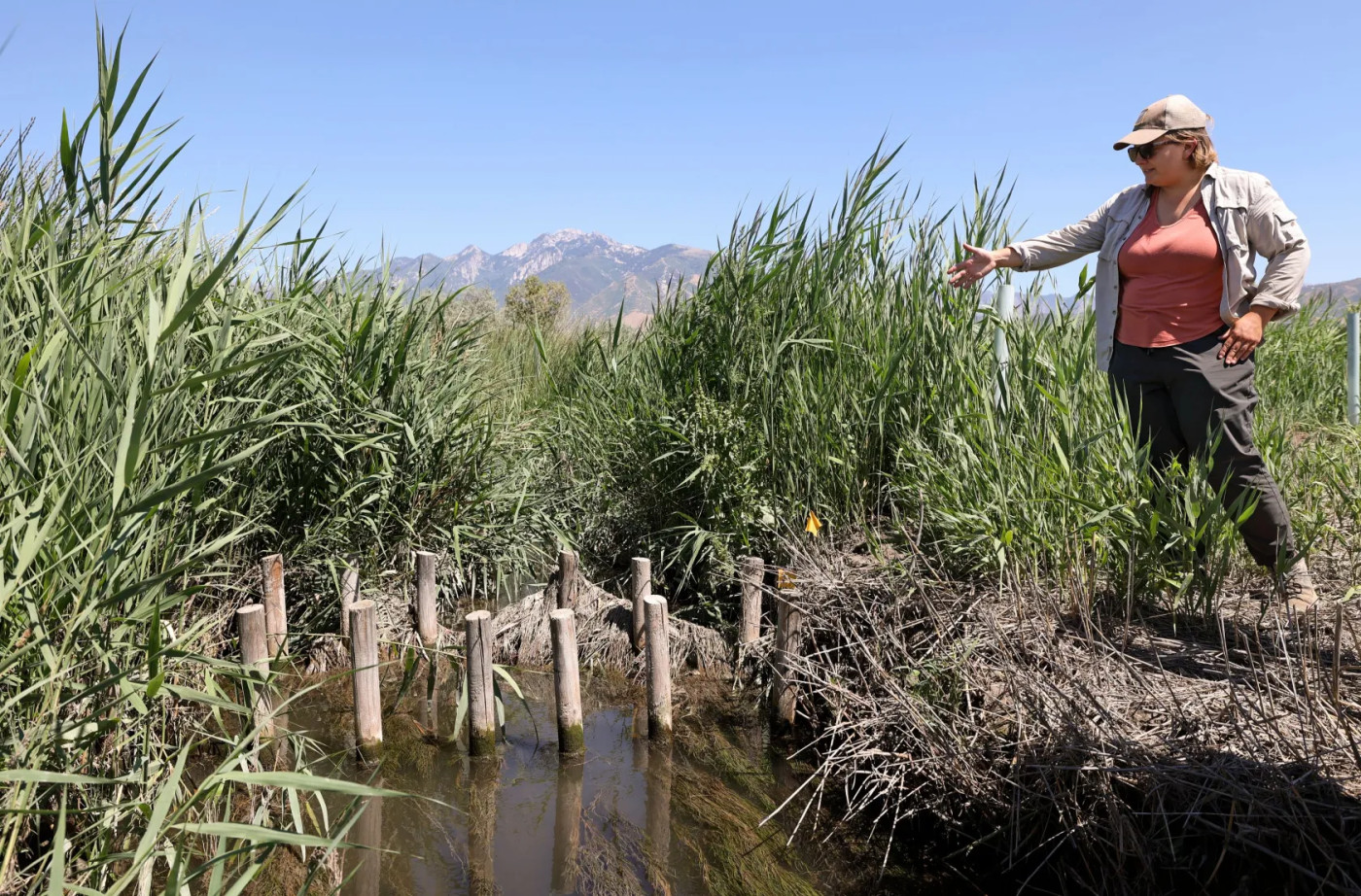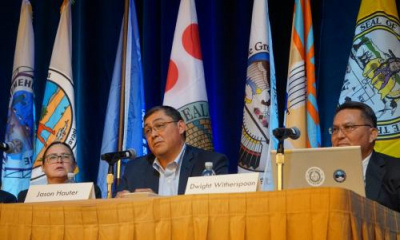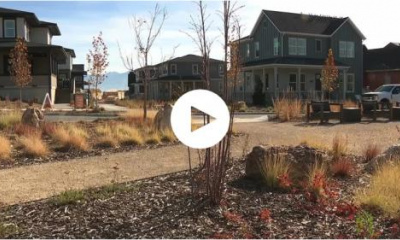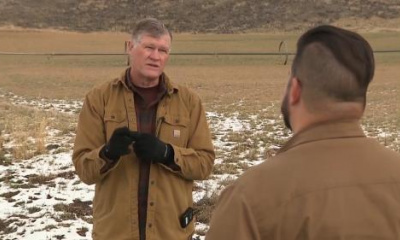About five years ago, Willy Stockman’s home on the bank of Emigration Creek became a wildlife hot spot.
In the summers of 2017 and 2018, elk, coyotes and turkeys started showing up in her backyard where she’d never seen them before. Huge elk herds came down the canyon and started occupying her and her neighbors’ yards.
Watch Fox13Now's report on beaver dam analogs here.
Though the creatures were a sight to see, it was a symptom of a big problem in the canyon: A severe drought meant upper parts of the canyon had no water, so wildlife were venturing further down the canyon in search of a drink.
“Parts of Emigration Canyon went dry and had never been dry before,” Stockman said. “People were putting out big bins of water, because there was no water. … And it’s all part of the big problem.”
Stockman, along with other residents of Emigration Canyon, formed the Emigration Canyon Sustainability Alliance in 2019 to improve water quality, increase stream flows and protect wildlife through groundwater studies, septic system planning and other actions.
One method the group is exploring to help improve the health of the Emigration Creek watershed involves mimicking another wildland creature — the North American beaver.
For many ecosystems, beavers are a keystone species, meaning other animals and plants in the ecosystem couldn’t survive without them. The industrious rodents’ dams create crucial wetland habitat for other species and help raise the water table so plant roots get a steady supply of water.
Beavers have been reintroduced for decades to restore riparian areas adjacent to waterways, improve stream health and create wetland habitat for birds and insects, according to the Utah Division of Forestry, Fire and State Lands. But some of these areas are too degraded or damaged, with steep, eroded stream banks and a lack of vegetation, to support beavers’ livelihoods.
Beaver dam analogs, essentially human-made replicas of natural beaver dams, provide benefits to ecosystems and waterways that the buck-toothed burrowers would add in areas that beavers can no longer inhabit. Humans install wooden posts in the stream channels and then weave willows to fill in the gaps.
Completed analogs are designed to kick-start the natural processes of preserving floodplains, restoring wetlands, supporting native vegetation, reducing downstream sedimentation, improving water quality and reducing erosion. Analogs can also improve streams enough to once again make them habitable for real beavers.
In Oregon, one study found that analogs increased the amount of groundwater near streams where they were installed, and that they helped restore riparian areas by stimulating willow growth.
A study in California found that analogs added complexity to streams that had previously been lost. The study also found that the analogs helped connect streams to other waterways through floodplains.
Another Oregon study, commissioned by the U.S. Forest Service, found that analogs improved habitat for fish and other wildlife, and that they can muster the return of real beaver populations on agricultural lands.
Dozens of beaver dam analogs have been installed on Utah’s streams, including in the Rose Creek watershed near Herriman and Toll Canyon near Summit Park, according to Sageland Collaborative stream ecologist Rose Smith.
Sandwiched between a golf course and a slew of new corporate buildings and apartment complexes sits Galena-Soo’nkahni Preserve, a 250-acre swath of wild sageland nestled in suburbia. A stretch of Corner Canyon Creek flows through the Draper preserve, which is permanently protected through a conservation easement. It’s here that conservationists have started installing eight beaver dam analogs near the creek’s confluence with the Jordan River.
The small stream is so deeply eroded into the earth that you might not notice it’s there until you fall into it. Invasive phragmites have taken over the creek’s banks, with thickets so tall and dense that Keith Hambrecht, Utah Division of Forestry, Fire and State Lands invasive species coordinator, has used a chainsaw to mow them down.
Still, Hambrecht and Smith say this stretch of creek is a great place for beaver dam analogs. Land managers are trying to make as much habitat for native species as possible over the preserve’s 250 acres, and analogs are one way to do that, Hambrecht said.
“We know this land is protected forever, so it’s worth investing in,” he said.
On a hot August afternoon, the half-finished Corner Canyon analogs are already starting to work as intended. Even though they’re just posts poking out of the water, vegetation is getting caught between the posts, helping to filter out sediment from the stream. In the fall, volunteers will finish properly installing the analogs, weaving willow and pine together to stick between the posts.
Blue tubes installed around willows on the streambed protect the plants from herbicides sprayed to kill phragmites, and help their roots grow deep enough to find water that invasive species aren’t already sucking away.
Smith hopes the analogs will expand the area on either side of the creek where these willows and other native plants can find groundwater. The analogs will periodically force water to flow over the creek’s banks and spread out, replenishing the groundwater and expanding the riparian area next to the creek where plants can grow, she said. If beavers are reintroduced to the area in the future, they’ll need a steady supply of willow to eat, Smith added.
“Beaver are our friends, and there are a lot of situations where we can live with beaver,” Smith said. “The more that we can all figure out ways to do that, I think the better off we’ll be and the more resilient our riverscapes will be to drought and fire.”
Once the analogs are finished, conservationists will gauge how well they’re working with a system that scores the analogs across 25 different stream and watershed health metrics, including fish and wildlife habitat, riparian vegetation and water quality, she said. Ecologists will also monitor the analogs with drone photography.
Could beaver dam analogs help raise the Great Salt Lake’s water level? Probably not, says hydrologist Konrad Hafen, who studied beaver dams’ ability to store water as a Utah State University researcher. The benefits of beaver dams and analogs are likely more realized further upstream in watersheds, he said.
Hafen studied beaver dams in the Bear River Basin, one part of the Great Salt Lake watershed. His research found that if all the water stored behind beaver dams in the Bear River Basin was released over a 30-day period — a best-case scenario — that would likely amount to a streamflow increase of less than 1%. That isn’t significant enough to be measured by most standards, he added.
But beaver dams and analogs provide many benefits to streams and watersheds beyond holding water, and according to Hafen’s research, the ability for beaver dams to store snowmelt water isn’t insignificant. In areas where human-made reservoirs aren’t feasible, beaver dams can act as dozens of tiny, water-retaining reservoirs, Hafen’s research suggested.
“The places where it could have an increase are going to be higher up in the system, you know, on the smaller streams that can support high densities of beaver dams,” Hafen said. “And so those are areas where you could potentially see an increase in (stream) flow.”
Though beaver dam analogs have a great deal of benefits for stream health, they don’t work everywhere and are usually meant only to be a temporary solution, Smith said. In cases like Corner Canyon, phragmites and other invasive species need to be cleared out first, or beaver dam analogs might actually help the weeds keep growing.
“If you’re not careful, you can be creating more habitat for invasive species,” Smith said.
The analogs also require regular monitoring, so you can’t just “set it and forget it,” she added.
The loss of beaver dams in areas where they’ve historically been present are tied to some of the same issues of suburban sprawl and agriculture expansion that affect the Great Salt Lake’s dwindling water level, according to Hafen. Urban areas on the Wasatch Front probably had more beaver dams before they were developed for human habitation. And agriculture often uses land that might otherwise be suitable for beaver habitat, he added.
“I think there are a lot of situations where installing (analogs) or encouraging beavers to build dams could be helpful, ecologically or ideologically,” Hafen said. “But I think you also have to take that on a case-by-case basis, consider what the goals are for restoration, what the restoration needs are and how those things are going to impact the surrounding landscape.”
Even though beaver dam analogs might not directly raise the water level of the Great Salt Lake, Stockman believes they can be one part of the process of improving the health of the lake’s watershed — and helping those elk, coyotes and turkeys avoid her backyard for greener pastures up-canyon.
“Sometimes I’m thinking of Utah as … a dry orange. It’s not as if you don’t have water anymore — you can stick a straw in it, suck it out, put the water in a reservoir. But in order to get a better fruit, you have to take care of a tree, and a tree is a watershed. That’s where our water is coming from,” Stockman said. “I sometimes think that there is too much focus on seeing the water and not realizing that it’s all of it. We need to address the actual health of the watershed. And so the (beaver dam analogs) are one way to do that.”









